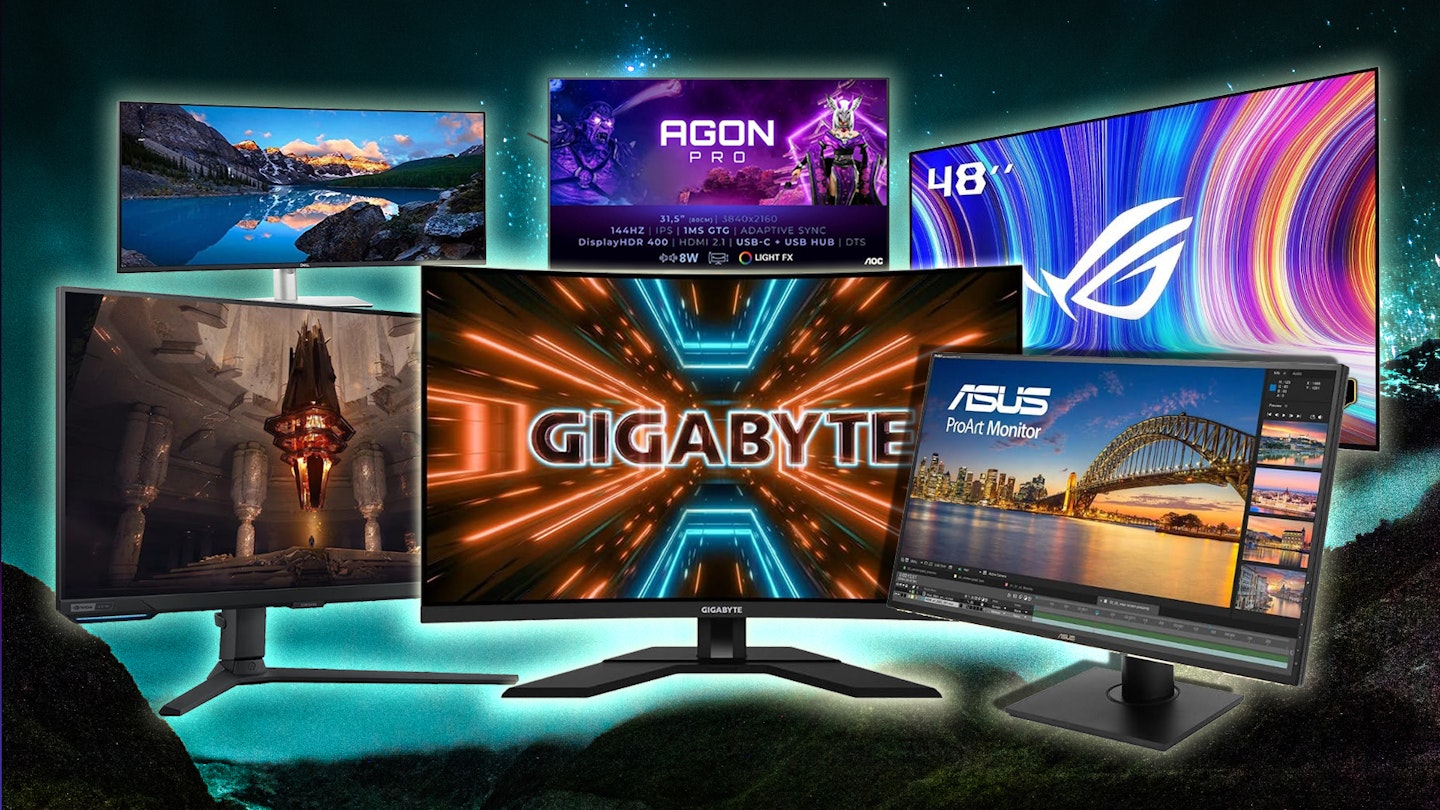Hunting down the best PC monitors can be tricky enough, but finding the best 4K monitors introduces another level of complication - for those new to 4K and high-def acolytes alike. Like most tech, 4K displays are now cheap enough to be commonplace, and so the marketplace is full of impressive-looking monitors that promise mind-bending detail and realism. But are they really that good?
Well, it depends. Thankfully, the tech experts here at What's The Best have taken a high-definition toothcomb to the growing list of manufacturers, models and spec sheets - from high-end screens to budget monitors. We've looked at screen size, refresh rate, ports and more; then put the very best 4K monitors into useful categories to help you choose. One thing's for sure: 4K is easy on the eyes - the added pixel count really does count.
The best 4K monitors of 2024 at a glance:
• Best overall 4K monitor: ASUS TUF Gaming VG289Q - View at Amazon
• Best budget 4K monitor: KOORUI 27 Inch 4K Computer Monitor - View at Amazon
• Best office 4K monitor: ASUS VP32UQ Eye Care Monitor - View at Amazon
• Best for designers: ASUS ProArt Display PA329CRV Professional Monitor - View at Wex Photo Video
Different monitors are designed for different purposes. If you're a gamer you'll want fast response times and high refresh rates. Those who need a monitor for photo editing will want a high colour range and accurate colour reproduction. For most users, a 4K monitor that is flicker-free and running at 60hz or more will be comfortable to use, especially as a monitor for a home office or study. Whatever you need it for, there's a 4K monitor to suit you.
To make things a little easier, we've included a guide to common monitor jargon, described the different panel types, and answered some of your questions. So, let's ditch that fuzzy old screen, clear some desk space and get ready for some of the best 4K monitors available right now.
The best 4K monitors of 2024
All prices are correct at the time of writing. Prices, stock and deals are subject to change without notice.
Our favourite 4K monitor is this, the ASUS TUF Gaming VG289Q. While it does have gaming in its name, it is suitable for much more. At 28 inches, it's an excellent size without being too large for a desk. The interface is simple to use and the settings are easy to tailor to your liking. It's also very bright, sporting an excellent 350 nits, and the colour support is also noteworthy.
One of our tech writers, Kyle Purves, has reviewed the ASUS TUF Gaming VG289Q and had this to say "Considering that gaming is a part of its name, it should come as no surprise that the VG289Q is an ideal monitor for gamers looking to upgrade their setup. Whether you primarily play on a console or on a PC, it's easy to focus on the specs of those devices in the pursuit of stunning visuals, but investing in a main display like this one is something you should never overlook.
"It's not just for gamers, though. I believe the VG289Q is well-suited for anyone in the market for a 4K monitor. With its expansive settings, streamlined design and user experience, and very practical Low Blue Light feature, this monitor is versatile enough for a bit of everything."
Pros
- Menus are easy to navigate
- Excellent visuals
- Impressive brightness
Cons
- Very awkward to reach the ports
| Resolution | 4K |
| Screen size | 28 inches |
| Screen type | LED IPS |
| Refresh rate | 60Hz |
| Response time | 5ms |
| HDR | HDR 10 |
| Ports | HDMI x 2, DisplayPort, Earphone Jack |
| Colour support | 1073.7M |
| Brightness | 350 nits |
| Viewing angle | 178 degrees |
Best versatile monitor
 Samsung
Samsung Despite being labelled a gaming screen, a formidable 4K monitor this most definitely is. Obviously, this Samsung Odyssey G7 is ideal for gaming and movies, and anyone who wants more pixels. Spec-wise, you have cutting-edge features like a 144hz refresh rate, fast 1ms response time, and HDMI 2.1 to support 4K at high refresh rates.
This Samsung sports an IPS panel for excellent colour and detail, plus the Pro version of AMD FreeSync for very low input lag, not to mention variable refresh rate and anti-screen-tearing if you are a gamer. And you won't be short of ways to connect this, as there's DisplayPort, HDMI, and USB. Surprisingly, this also has ethernet and wifi - which is handy because we also get Samsung TV Plus and Gaming Hub. So, you can even watch TV and movies on this absolute beast of a 4K monitor, which is why it takes our top spot here.
Pros
- Legendary Samsung design and build - solid and reliable with a beautiful 4K panel
- Built-in WiFi for TV and cloud gaming
- Good connection options and built-in speakers for a simple yet flexible setup
Cons
- The speakers are okay, but a soundbar will be better
| Resolution | 3840 x 2160 |
| Screen size | 28 inches |
| Screen type | IPS |
| Refresh rate | 144hz |
| Response time | 1ms |
| HDR | HDR400 |
| Ports | HDMI x2, DisplayPort, USB Type A |
| Colour support | 95% DCI-P3, 125% sRGB |
| Brightness | 400 Nits |
| Viewing angle | 178° |
Best budget
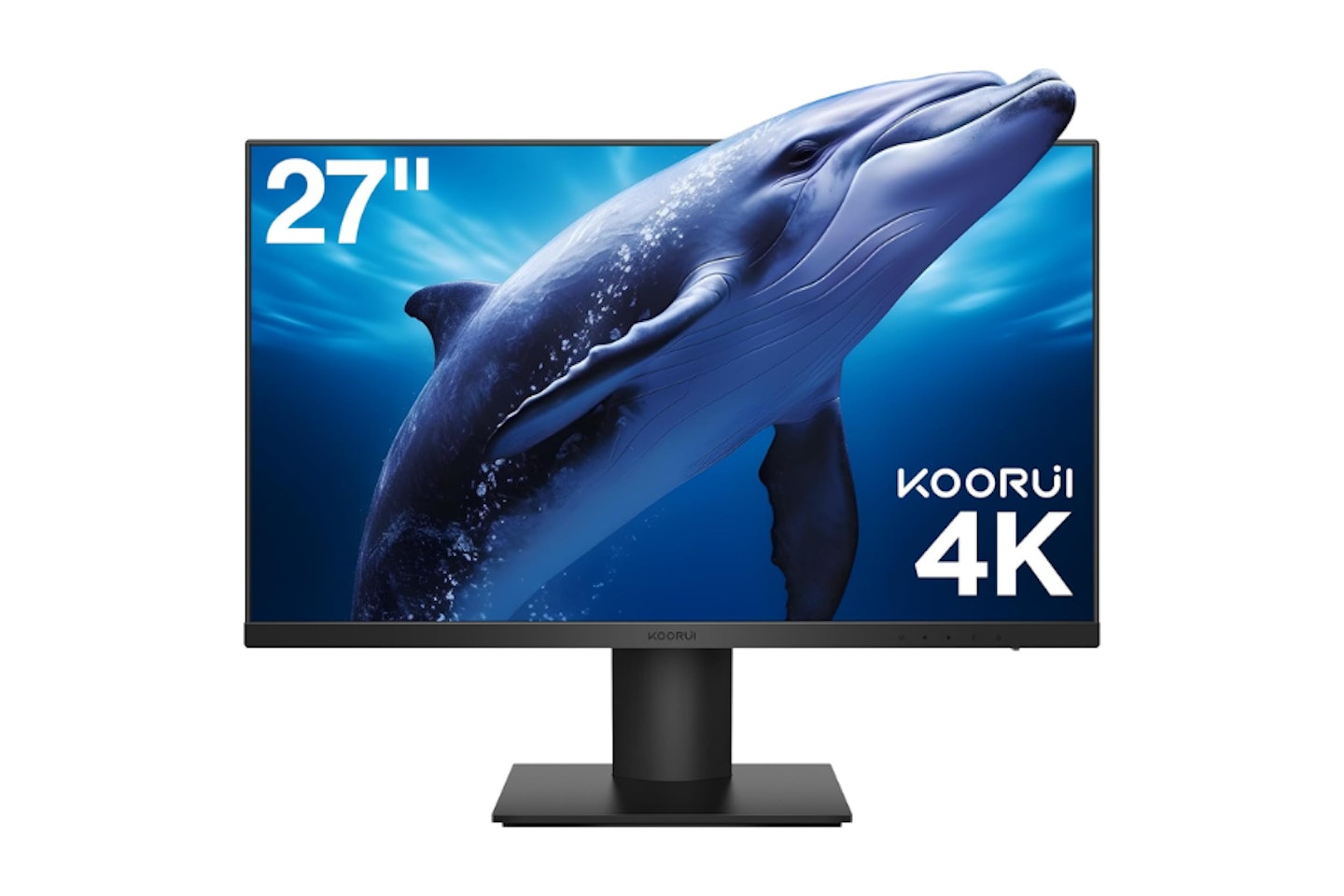 Koorui
KooruiThis 27-inch model from the popular brand KOORUI is a prime example of a basic-looking but highly regarded affordable 4K screen. And the key features are impressive. It’s 4K with HDR10 support – so all those extra colours are going to look great. There’s a DisplayPort connection as well as HDMI for flexibility if you have a PC or a Mac.
Plus, it’s an IPS panel with a side viewing angle - a definite step up from other low-budget monitors. The backlight can be a little bright at times, so if you’re an avid movie watcher or into serious design you might want to up your budget slightly. That said, extra features include loads of image modes, eye care and more. We think it’s a bit of a hidden gem in the low-budget bracket.
Pros
- Hard to find a better-value 27-inch monitor with a 4K resolution
- Supports HDR10 for extra colour range
- Great pre-set modes and eyecare features for adjusting the image
Cons
- The backlight isn’t as refined as some others
| Resolution | 3840 x 2160 pixels |
| Screen size | 27 inches |
| Screen type | IPS |
| Refresh rate | 60Hz |
| Response time | 4ms |
| HDR | HDR10 |
| Ports | 2x HDMI 2.0, 1x DisplayPort 1.4, 1x Audio In, 1x Headphone Jack |
| Colour support | 90% DCI-P3 |
| Brightness | 268 Nits |
| Viewing angle | 178° |
Best office monitor
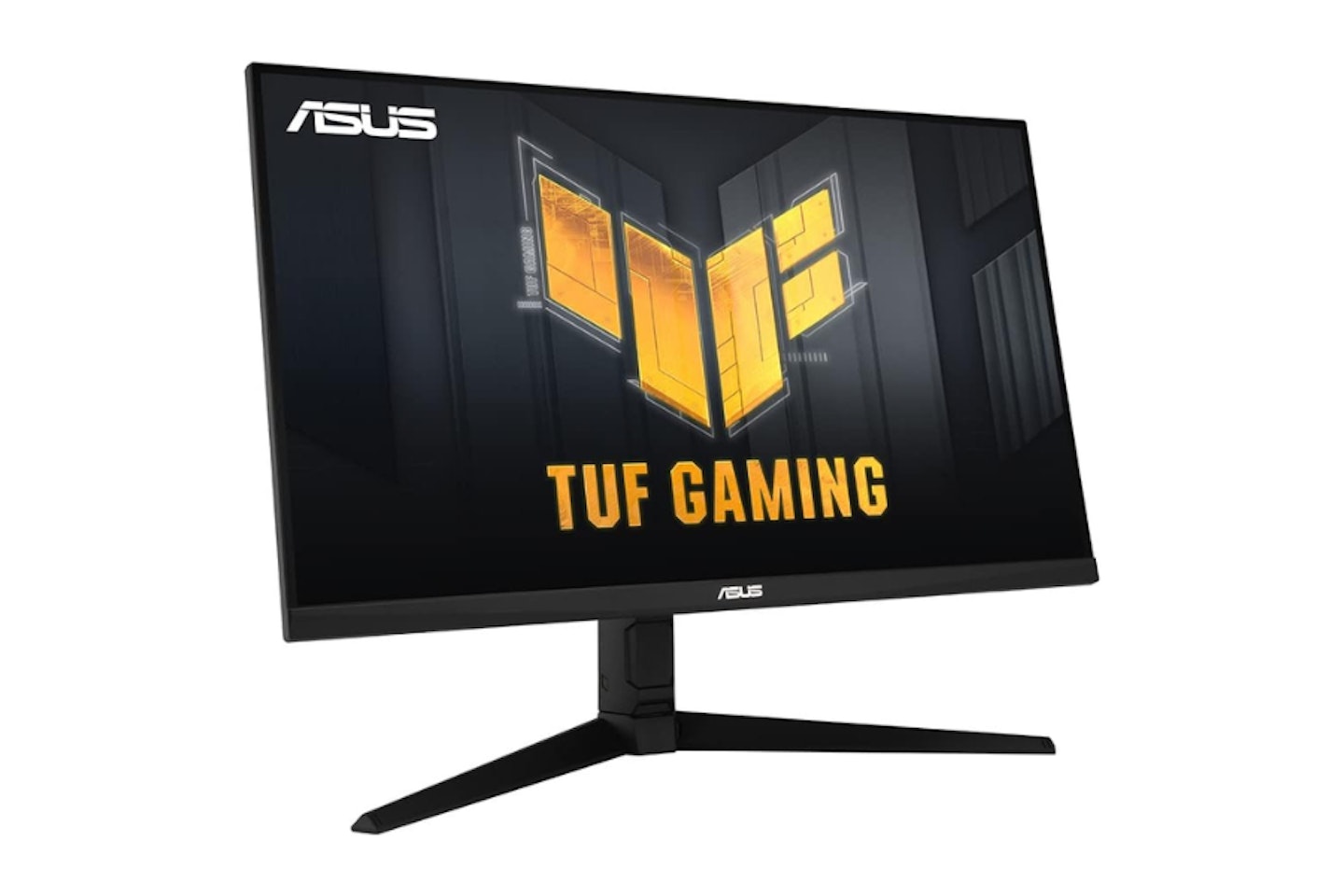 ASUS
ASUS The ASUS VP32UQ Eye Care Monitor is a solid choice for anyone looking to up their resolution game for general use and work. The refresh rate is a model 60hz, but it does at least come with Adaptive Sync for a smoother casual gaming experience. That said, the 60hz refresh rate is fine for anyone working on these screens for several hours at a time. This is a flicker-free monitor with a blue light filter too - so eye comfort is well-catered for.
The design is simple and refined, and the build is solid. Having thin bezels on a budget screen is a welcome finishing touch too. But the goodies don't stop there, as this ASUS even comes with HDR10 (with multiple modes) for an extended colour palette and more depth. And it's easy to forget, given the price, that this really is a 4K 31.5-inch screen. Stunning features for an incredible price.
Pros
- Excellent eye care features make this the ideal choice for those longer work sessions
- HDR10 support for over a billion colours means this is also good for media
- Slim bezel and a wide viewing angle makes this monitor a pleasure to use
Cons
- Limited connectivity compared to others so plan your number of inputs and connection types
| Resolution | 3840 x 2160 |
| Screen size | 31.5" |
| Screen type | IPS |
| Refresh rate | 60hz |
| Response time | 4ms |
| HDR | HDR10 |
| Ports | 1 x DisplayPort, 1 x HDMI |
| Colour support | 100% sRGB color gamut |
| Brightness | 350 cd/m² (Nits) |
| Viewing angle | 178° |
Best for designers
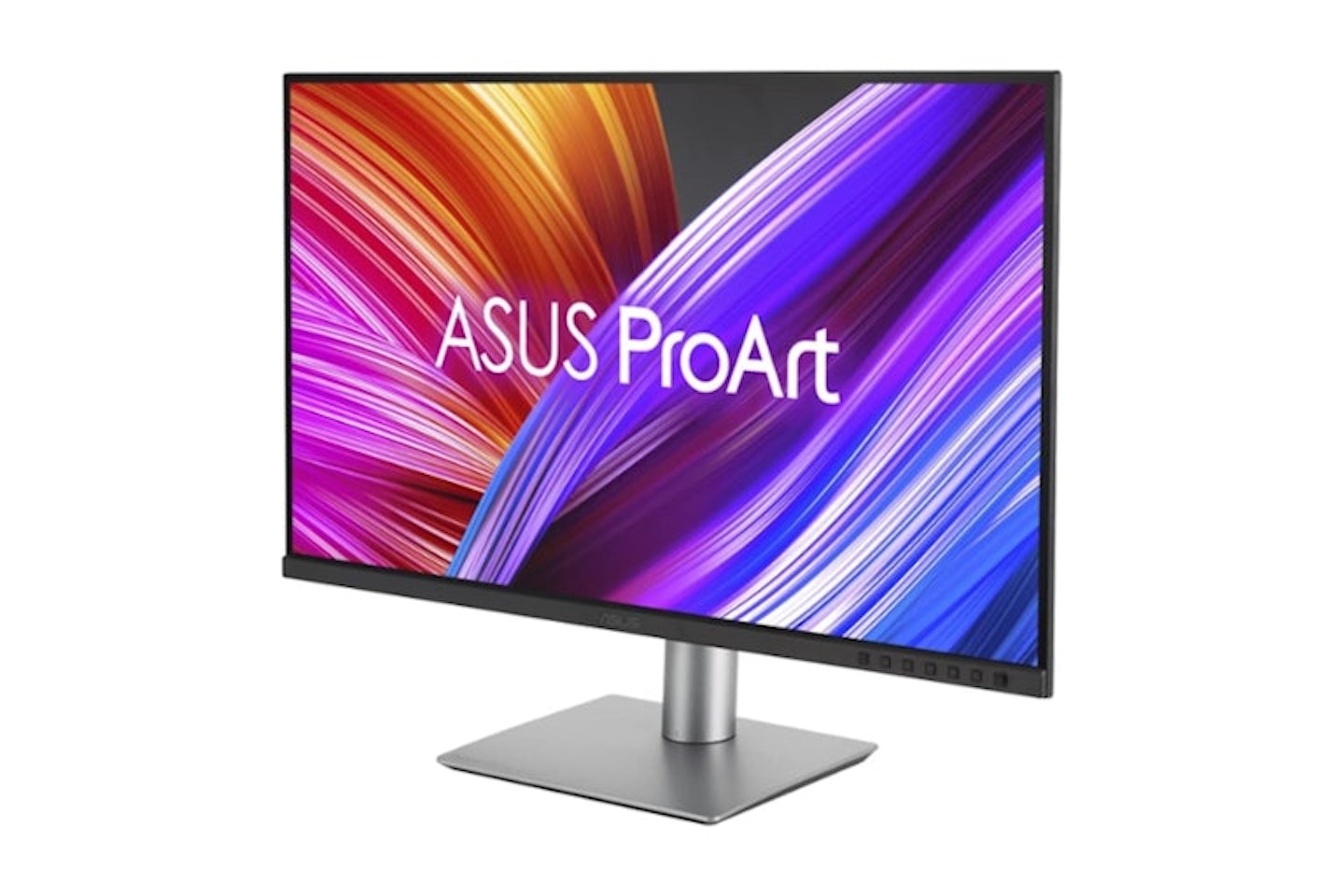 ASUS
ASUSwww.wexphotovideo.com
If there's one thing that all designers need, it's accurate colour representation. You need what you see on screen to translate into print or look great on television if you're a video editor. This ASUS ProArt's 32-inch IPS screen is laden with more colour accreditations than you can shake a digital paintbrush at. There's 100 per cent sRGB, 98 per cent DCI-P3 and more. For out-of-the-box colour calibration, this PA329C doesn't disappoint - with Calman Verified status.
Now, back to the key feature here - it's a large 4K monitor with a neat and refined design - including USB-C for neat power and connection options. That means that not only will it fit into any home studio environment, but it'll give all creatives an accurate and detailed window into their digital world.
Pros
- A beautiful 4K screen with excellent HDR vibrancy - ideal for creatives or movie fans
- All that 4K goodness is delivered with amazing colour accuracy, thanks to 98% DCI-P3, 100% sRGB and Calman Verification
- The USB-C port makes for a tidy setup with power delivery for your laptop
Cons
- Despite HDR 400 being a step up from the norm, we would have liked to see HDR10 support for those who need it
| Resolution | 3840 x 2160 pixels |
| Screen size | 31.5" |
| Screen type | IPS |
| Refresh rate | 60hz |
| Response time | 4ms |
| HDR | HDR 400 |
| Ports | 1x USB-C (DP Alt Mode, 96W Power Delivery), 2x DisplayPort 1.4, 2x HDMI 2.0, 1x USB-A 3.2 Gen 1, 1x 3.5mm headphone jack |
| Colour support | 98% DCI-P3, 100% sRGB, Calman Verified with Delta E 2 |
| Brightness | |
| Viewing angle | 178° |
Best ultrawide 4K monitor
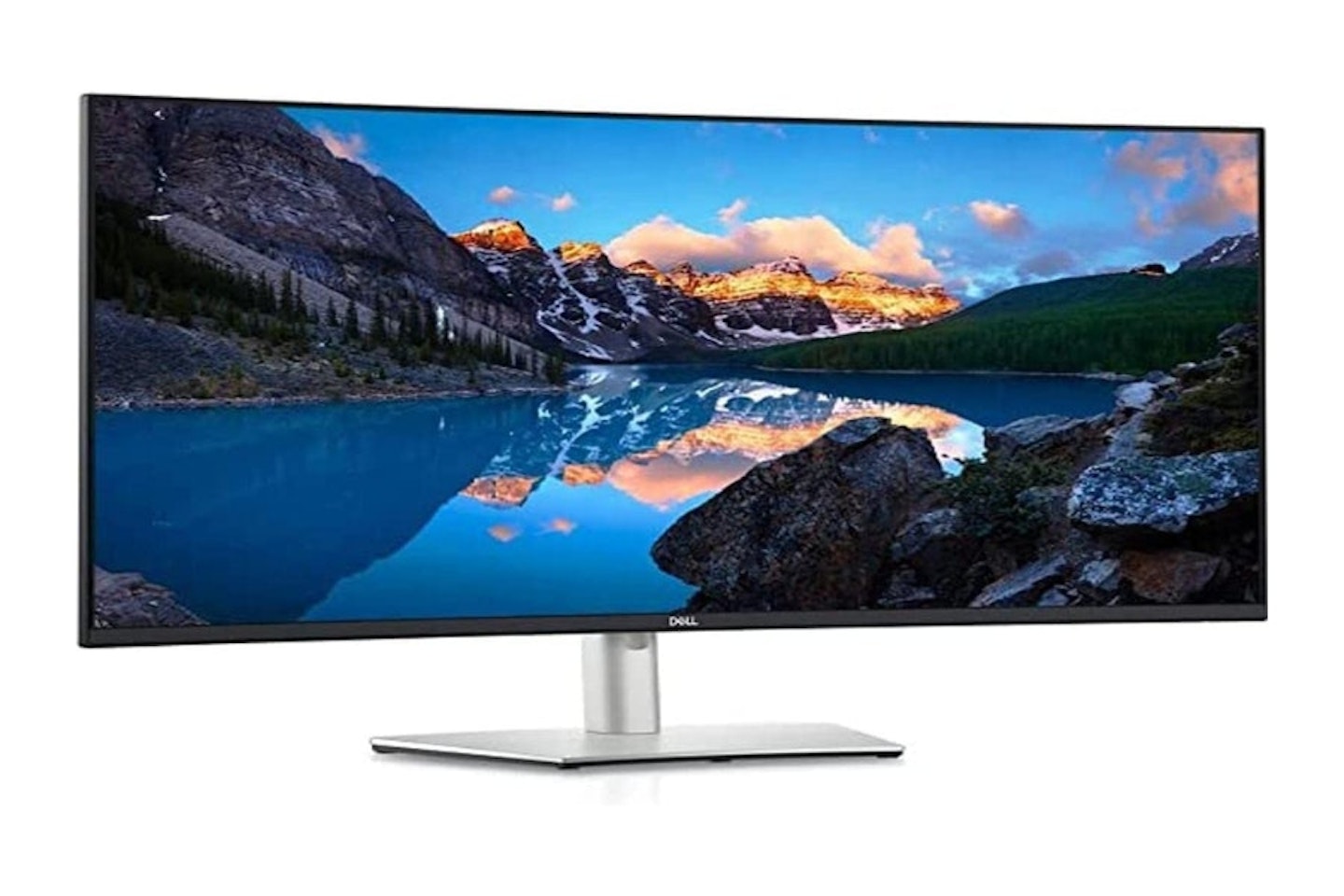 Dell
Dell www.avpartsmaster.co.uk
Despite 4K ultrawide monitors normally having a resolution of 3840 x 2160, this Dell Ultrasharp has filled its 40-inch curved screen with the correct number of pixels for a true 4K resolution of 5120 x 2160. That's pretty astonishing, making it one of the few 4K ultrawide monitors available. The aspect ratio is a staggering 21:6 - that's close to the equivalent of a couple of 4K screens in one.
Gamers will probably have their finger hovering over the 'buy' button, but gaming isn't a high priority for this monitor. The panel on this Dell is 60hz with a 5ms response time - perfect for general use, design and movies, but gamers will usually need higher. Mac designers will love the addition of Lightning connections, and there are even some internal 9W speakers if you're stuck for a soundbar. For true 4K in an ultrawide format, this is stunning.
Pros
- Beautiful and true 4K resolution - a rarity with ultrawide screens
- Sleek design with plenty of input options for a smart setup
- Built-in KVM switch and speakers for ease of use
Cons
- Not the best response time here, but good enough for most
| Resolution | 5120 x 2160 |
| Screen size | 40" |
| Screen type | IPS |
| Refresh rate | 60hz |
| Response time | 5ms |
| HDR | HDR10 |
| Ports | 2 x HDMI (HDCP 2.2), DisplayPort (DisplayPort 1.4 mode, HDCP 2.2), Thunderbolt 3 / USB-C upstream, 3 x USB 3.2, Audio line-out |
| Colour support | 100% sRGB, 98% DCI-P3 |
| Brightness | 300 cd/m² (Nits) |
| Viewing angle | 178° |
Best 43-inch 4K monitor
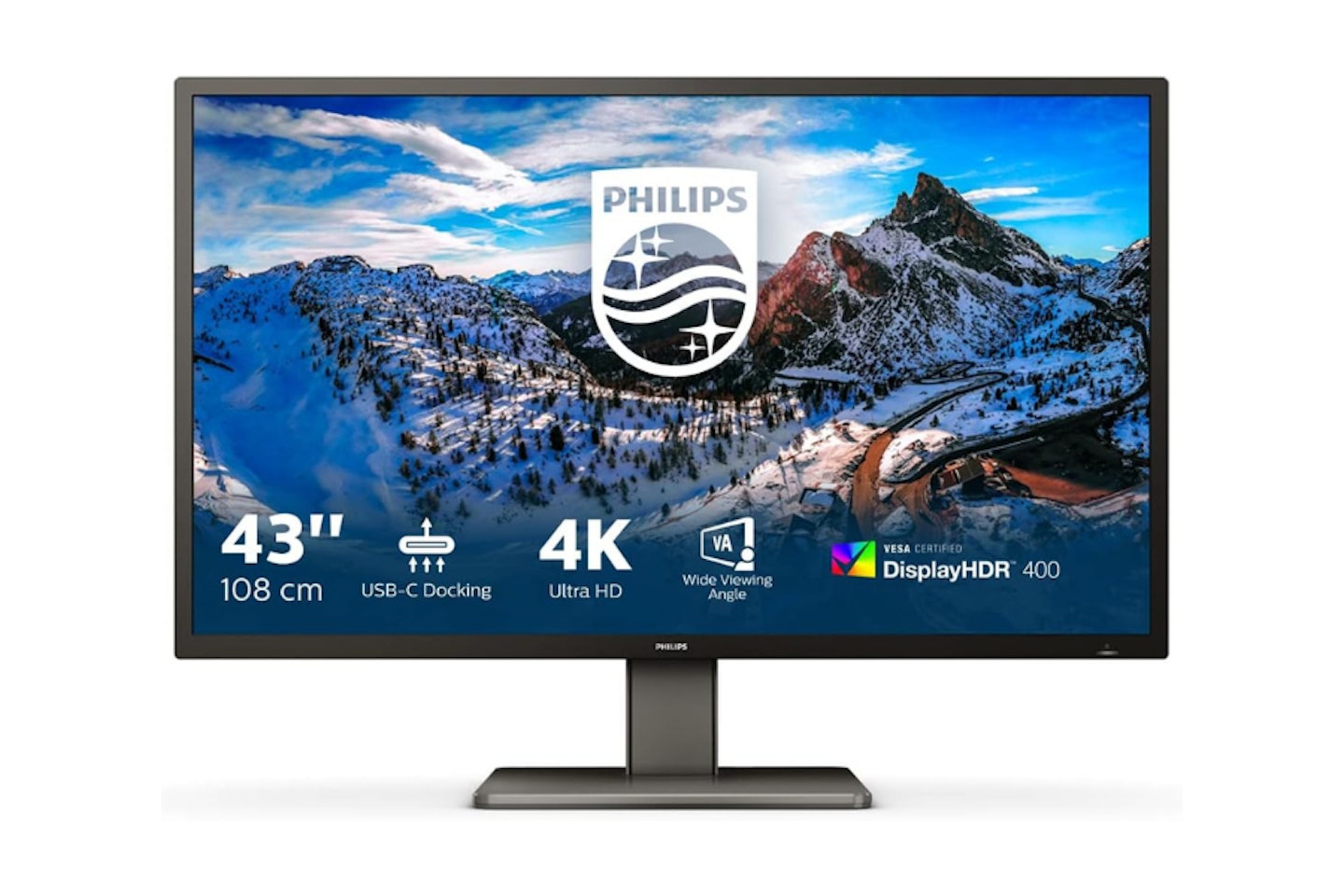 PHILIPS
PHILIPS When 32 inches of screen real estate isn't quite enough, but 50 inches or beyond is overkill, this 43-inch monitor from Philips is the perfect option. As you'd expect, there's a comprehensive range of ports for multiple devices too. And, as a monitor on the larger side, it comes with a few more bells and whistles to make the best use of all that space. There's a host of filter modes for fine-tuning the image, plus multi-viewing options and HDR for extra colour range.
We think there are so many use cases for this 4K monitor - from video editing and graphic design to studying or working from home. And, when you consider the sheer size and the reliable brand on offer here, the Philips 439P1 is remarkably good value.
Pros
- Vibrant 43-inch display with lots of connectivity
- Fantastic multiview option and LowBlue mode filters to customise your experience
- The reliable Philips build and design look great on the desktop
Cons
- The bezel is a little thick for a monitor this large when compared to those seen on large TVs
| Resolution | 3840 x 2160p |
| Screen size | 43-inch |
| Screen type | VA |
| Refresh rate | 60Hz |
| Response time | 4ms |
| HDR | HDR 400 |
| Ports | DisplayPort 1.4 x 1, HDMI 2.0 x 2, HDMI 1.4 x 1 |
| Colour support | 1.07 billion |
| Brightness | 400 cd/m² |
| Viewing angle | 178-degrees |
Best curved 4K monitor
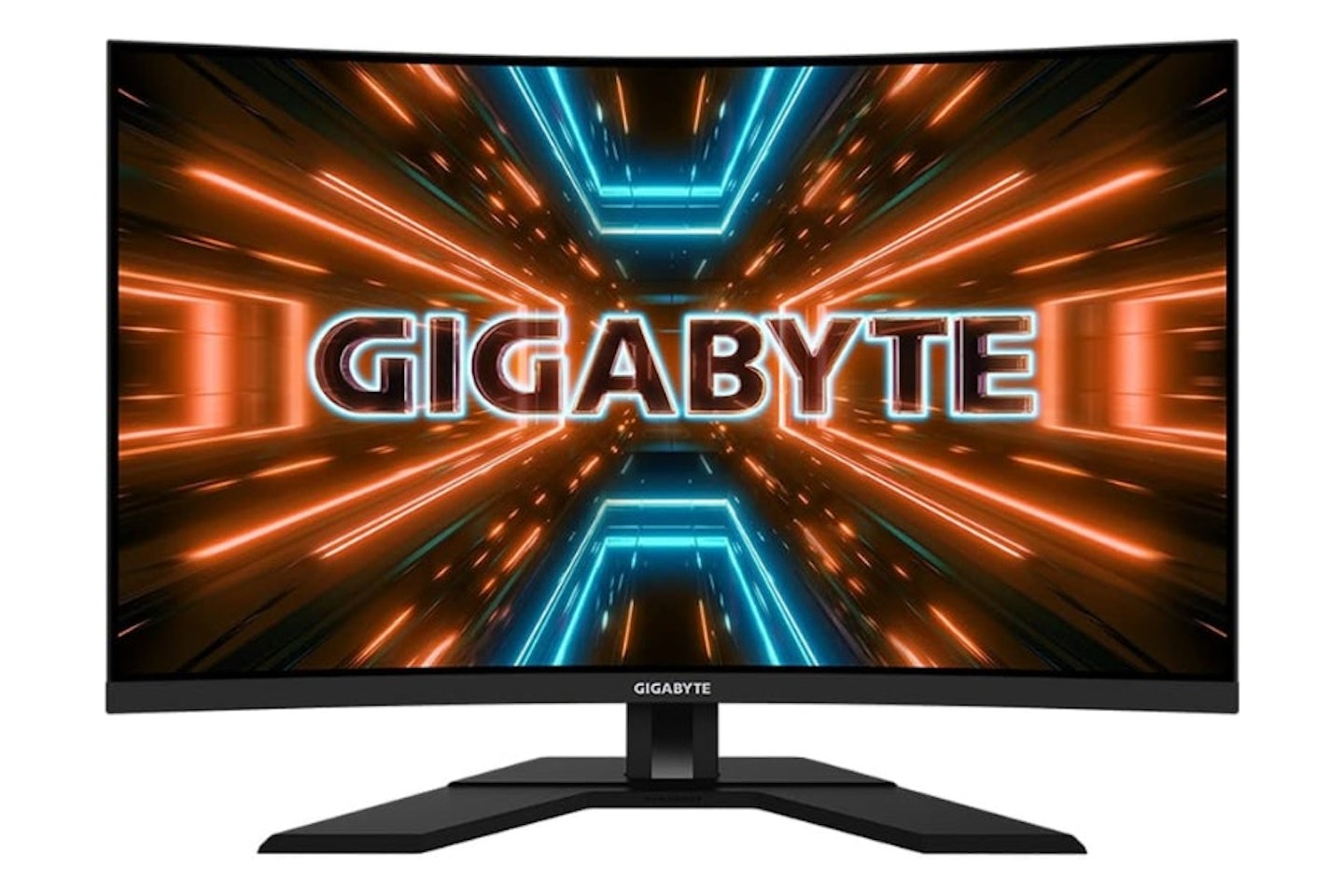 Gigabyte
Gigabyte Whilst this isn't the only curved screen on this list, we know that curved monitors aren't for everyone. However, anyone who's used one says that the immersive wrap-around feel is unbeatable. This 32-inch 4K screen from Gigabyte is an impressive beast. Having a curve on something this big really adds to the sense of realism and immersion, no matter what you're doing. The panel, unlike others here, is a SuperSpeed VA panel, so the welcome addition of FreeSync Premium Pro will compensate for the panel, and deliver a judder-free, low-input lag gaming session and slick 4K video.
There are some built-in speakers, but as always when it comes to monitors, we recommend an external USB soundbar or speaker setup to do this screen justice. A KVM switch makes for easy switching between consoles or a PC too. There's a good array of inputs, with DisplayPort 1.4, USB-C and USB 3. The contrast ratio of this monitor is an astonishing 3000:1 - often only seen on other competing panel technologies. If you're in the mood for an all-encompassing and vibrant picture, this Gigabyte will not disappoint.
Pros
- The curve accurately follows that of the human eye for a natural experience
- The brightness and high contrast ratio of this 4K screen is excellent for those who need more clarity
- Plenty of inputs so you can attach a number of devices to this for lots of flexibility
Cons
- The power supply is a power brick, not a lead
| Resolution | 4K UHD (3840 x 2160), |
| Screen size | 31.5" |
| Screen type | SuperSpeed VA panel |
| Refresh rate | 144Hz |
| Response time | 1ms |
| HDR | DisplayHDR 400 |
| Ports | DisplayPort, USB Type C, HDMI 2.1 |
| Colour support | 93% DCI-P3 with 8-bit Colour |
| Brightness | 500 cd/m² (Nits) |
| Viewing angle | 178° |
Best high-end 4K monitor
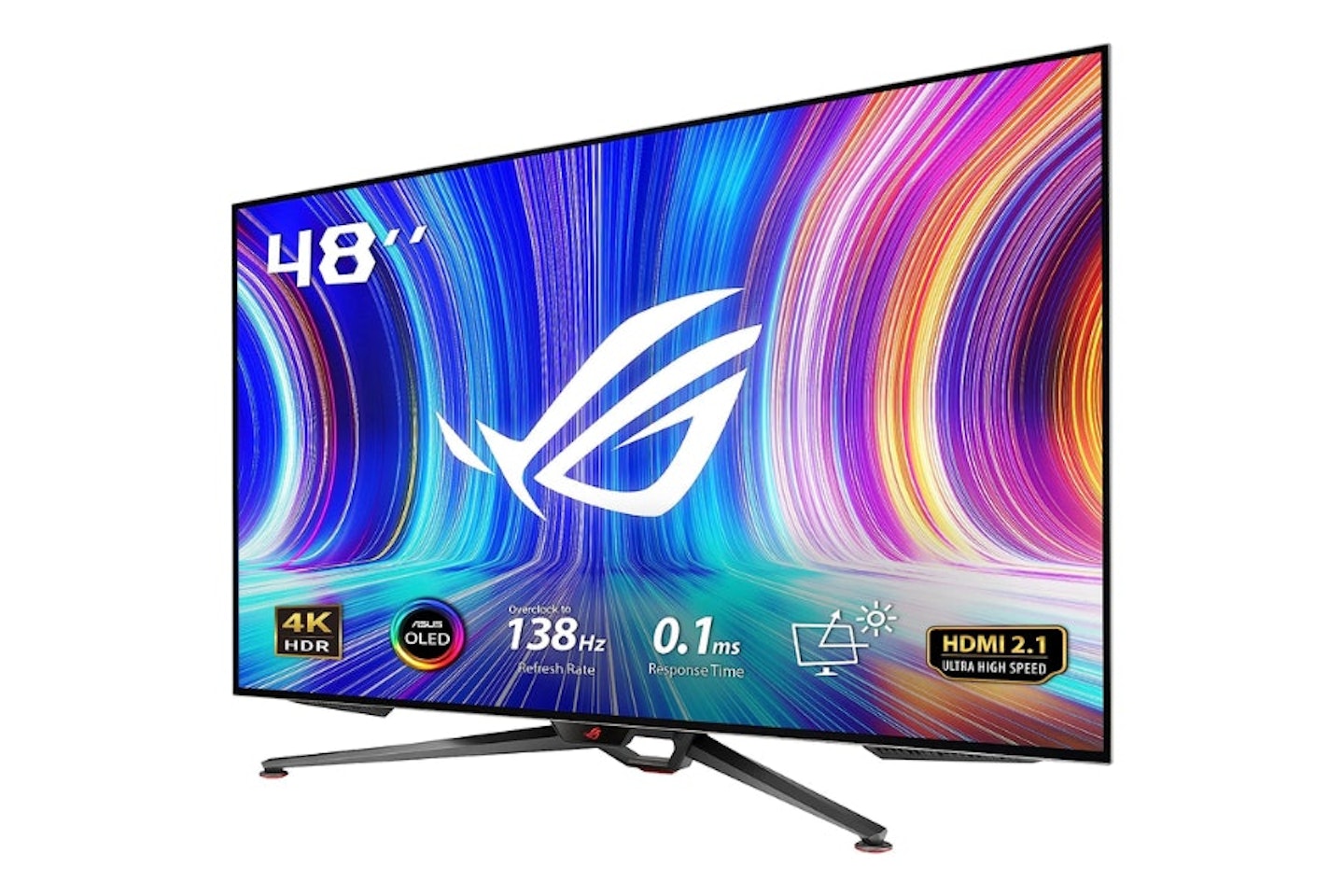 ASUS
ASUS While it's true that much of the cost of this ASUS ROG Swift monitor is down to the gargantuan 47.5-inch panel, the reason it's our pick in the high-end category is its high specifications. Some might say that the ASUS PG48UQ is an overpowered monolith, but we think that just makes it perfect for all uses - despite its clear gaming credentials.
Firstly, it's an OLED screen capable of producing over a billion colours. The 1ms latency will look after your reflexes when gaming, the 138hz refresh rate is there for smooth and detailed frame rates, and G-Sync will keep the screen from tearing and blurring with fast motion. Add extras like an anti-glare screen and 98 per cent DCI-P3 colour accuracy and this monitor is going to be great for creative work too. 4K monitors don't bet much bigger or better than this right now.
Pros
- The OLED screen at this massive scale really shows off those deeper blacks and vibrant colours
- Again, considering a screen of this size - you'll be glad of the anti-glare screen
- 138hz refresh rate, 0.1ms response time and G-SYNC compatibility make this a great screen for movies and games
Cons
- If you don't have the space to sit a sensible distance away from this on your desk you may want a smaller option
| Resolution | 4K - 3840 x 2160 |
| Screen size | 47.5" |
| Screen type | OLED |
| Refresh rate | 138Hz |
| Response time | 0.1ms |
| HDR | HDR10 |
| Ports | 1 x USB 3.2, 4 x USB 3.2, 2 x HDMI 2.0, 2 x HDMI 2.1, 1 x DisplayPort 1.4, 1 x 3.5 mm Audio Out, 1 x 3.5 mm Audio Out |
| Colour support | sRGB 133%, DCI P3 98% |
| Brightness | 450 cd/m² (Nits) |
| Viewing angle | 178° |
Best for Macs
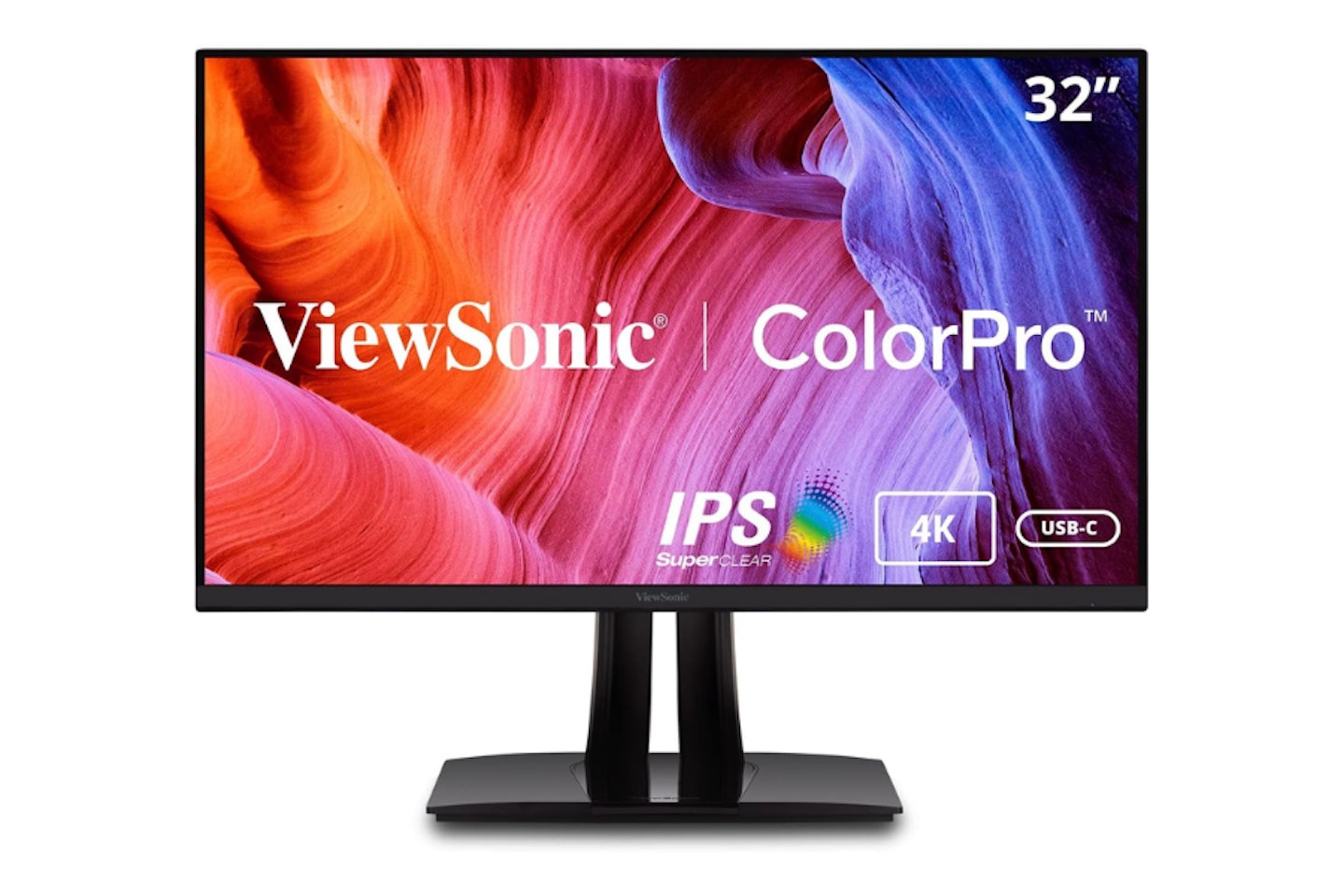 ViewSonic
ViewSonicThis ViewSonic VP3256-4K is a brilliant 32-inch 4K screen upgrade for any Mac. Sporting a wide range of colour accreditations (including from Pantone and 100 per cent sRGB gamut coverage) the 32-inch IPS panel is ideal for video editors and other creatives as well as for entertainment. There’s even blue light filtering and a flicker-free image to keep you watching in comfort.
And as for that viewing experience, if you’re going to be watching (or editing) any HDR content, the support for HDR10 is here too. With USB-C as well as DisplayPort, you have plenty of connection options too. Overall, this is a real performer for anyone looking to increase the screen size, resolution and colour range of their existing Macbook or Mac.
Pros
- A stunningly clear 4K panel with accurate colours
- HDR10 support means you can edit HDR video or view HDR content with beautiful results
- The slim bezel and 32-inch screen give you a clutter-free workspace
Cons
- Given the impressive specs, the design is a little plain
| Resolution | 3840 x 2160 pixels |
| Screen size | 32 inches |
| Screen type | IPS |
| Refresh rate | 60Hz |
| Response time | 4ms (GTG) |
| HDR | HDR10 |
| Ports | 2x HDMI 2.0, 1x DisplayPort 1.4, 2x USB-A 3.2 Gen 1, 1x USB-C (60W power delivery), 1x Audio In, 1x Earphone Jack |
| Colour support | 95% DCI-P3, 100% sRGB |
| Brightness | 311 Nits |
| Viewing angle | 178° |
Best for gaming
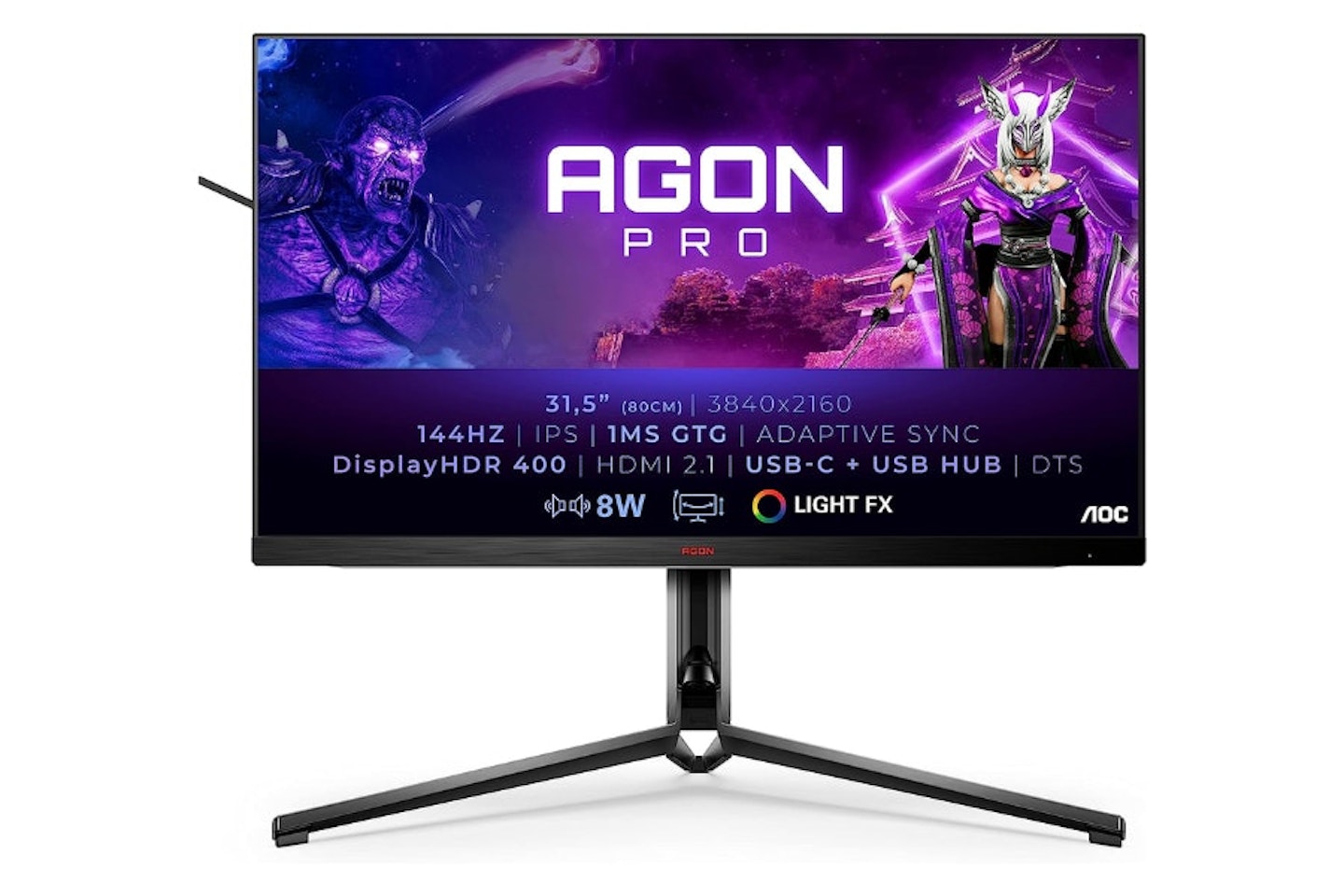 AOC
AOC4K gaming monitors are everywhere, but this AGON from AOC has what we think is a perfectly balanced spec and price. Firstly, its 32-inch IPS screen runs at 144hz, and it has HDMI 2.1. All of that means it'll support 4K gaming at 120hz for console gamers. And, of course, there's the prerequisite 1ms response time to deliver on your super-fast reflexes. One thing that can plague an underperforming 4K gaming monitor is the dreaded screen-tearing and motion blur. This AGON has Freesync Premium to really keep things smooth and detailed.
And this is the monitor that just keeps on delivering the goods for gamers. Breaking with monitor tradition, the built-in speakers are actually reasonable if you need to use them. USB-C is included too, and it supports high-power delivery for neatly daisy-chaining more devices if you need to. The USB hub is joined by a KVM switch too, so if you're lucky enough to have more than one gaming rig hooked up to this monitor, switching the keyboard and mouse is simple and clutter-free. Are we mentioned in our run-down of the best monitors for dual-screen setups, getting two of these AOC AGONs would make for every gamer's dream desktop.
Pros
- The 4K resolution plus 144hz refresh rate an 1ms response time is optimal for gaming precision
- Lighting effects to give your desktop the gamer aesthetic
- Built-in KVM and USB hub means you'll have less cable clutter and flexibility for a slick setup
Cons
- The stand is as wide as the screen, which might be intrusive
| Resolution | 4K 3840 x 2160 |
| Screen size | 31.5" |
| Screen type | IPS |
| Refresh rate | 144hz |
| Response time | 1ms GtG |
| HDR | DisplayHDR 600 |
| Ports | USB 3.2, headphone jack, 2x HDMI 2.1, 1x DisplayPort 1.4 |
| Colour support | 98% DCI-P3, 135% sRGB |
| Brightness | 600 cd/m² (Nits) |
| Viewing angle | 178° |
How to choose the best 4K monitor for you: Buyer's guide
Consider how you'll be using it
Most general users will work and watch videos or browse. That means any 4K screen - whether it's an IPS or a VA panel - is likely to be a perfect choice. But, if you want to use the monitor for design or video editing you'll want to look at the panel type and colour accuracy. IPS tends to be a wise choice for most,
As for gamers, even consoles will be fine, including having the best monitor for a PS5 - even if not all games are in 4K. PC gaming tends to be a little more demanding in terms of monitor specifications. A game may vary its output anywhere between 60 frames per second to 120 frames per second.
Unsurprisingly, your monitor should be able to match this as much as possible, and that's where Variable refresh rates (VRR) come in. Sometimes known as FreeSync or G-Sync, if a gaming monitor can take the varied frame rates kicked out by the graphics card, you're in for smooth, tear-free gameplay.
One final consideration is the panel type. The underlying tech that makes the screen display a picture counts for a lot. There's a brief run-down of these below, but in general, OLED panels, QLED and MiniLED are popular with creatives and movie fans thanks to their impressive contrast ratio and colour accuracy. High Dynamic Range (HDR) is also recommended here. And you might even like a curved monitor for even more immersion; and less eye strain thanks to more natural and consistent viewing distances.
Check your system
Some PCs have an HDMI port on the rear panel from the motherboard's onboard video input. Often, if the system is fitted with a dedicated graphics card, that original onboard port will be rendered useless. That means you need to inspect your graphics card and make sure that it has digital ports such as HDMI, DisplayPort, DVI (although that will be limited to lower resolutions) or the latest USB-C connection. And then...
Check your monitor's connections
Having identified which monitor ports you have available on your system, you'll need to make sure your chosen monitor has matching inputs. Thankfully, you can mix and match connection types - as long as they support the same resolution as each other. If your graphics card has one HDMI and one DisplayPort, each will support a range of high resolutions. If your PC doesn't have DisplayPort but does have HDMI, or vice versa, you can use DisplayPort to HDMI adapters.

Best 4K monitors of 2024: Frequently asked questions
Is a 4K monitor worth it?
As always, this really comes down to your budget. But, in short, yes. No matter what you're using it for, the added resolution will reduce eye strain. This is particularly true with monitors equipped with other eye care features. They also improve productivity.
More desktop space means more apps open at once, with room to really zoom in if you're a designer. And you can buy back some desk space by removing the stand and going for one of the best monitor arm mounts instead. If you're a gamer, you'll experience 4K once and then never go back. Investing in a 4K monitor really is a no-brainer these days, especially since prices are now very affordable.
What graphics card do I need for 4K?
If your system has a relatively modern dedicated graphics card, it's highly likely it will be capable of outputting 4K resolution. Even most motherboards with onboard graphics capability will support it. You may have an HDMI port or DisplayPort to hook your monitor up to. If in doubt. investigate your current computer system and see what it's capable of before you buy.
And a quick note on ultrawide monitors: A handful of these now support genuine 4K on a screen with wider ratio. Now, just because your machine can pipe out content at 4K, doesn't necessarily mean it can drive the screens. Ultrawide 4K screens have resolutions as wide as a staggering 5120 x 2160 pixels.
Can 4K monitors do 1440p?
Yes. Any screen that can display 4K is capable of displaying lower resolutions. The real issue here is whether or not the monitor can handle 1440p effectively. That's to say, the native resolution (the one the monitor is designed to display by default) may be 4K, but it will need to upscale 1440p to fit the native resolution.
Sometimes, because everything is effectively magnified, you'll more easily see some small digital artefacts from the upscaling. At the end of the day, if you're sitting at a proper distance and can accept the consequences of upscaling, there's no reason why you can't buy one of the best 4K monitors and play everything on it at 4K or lower.
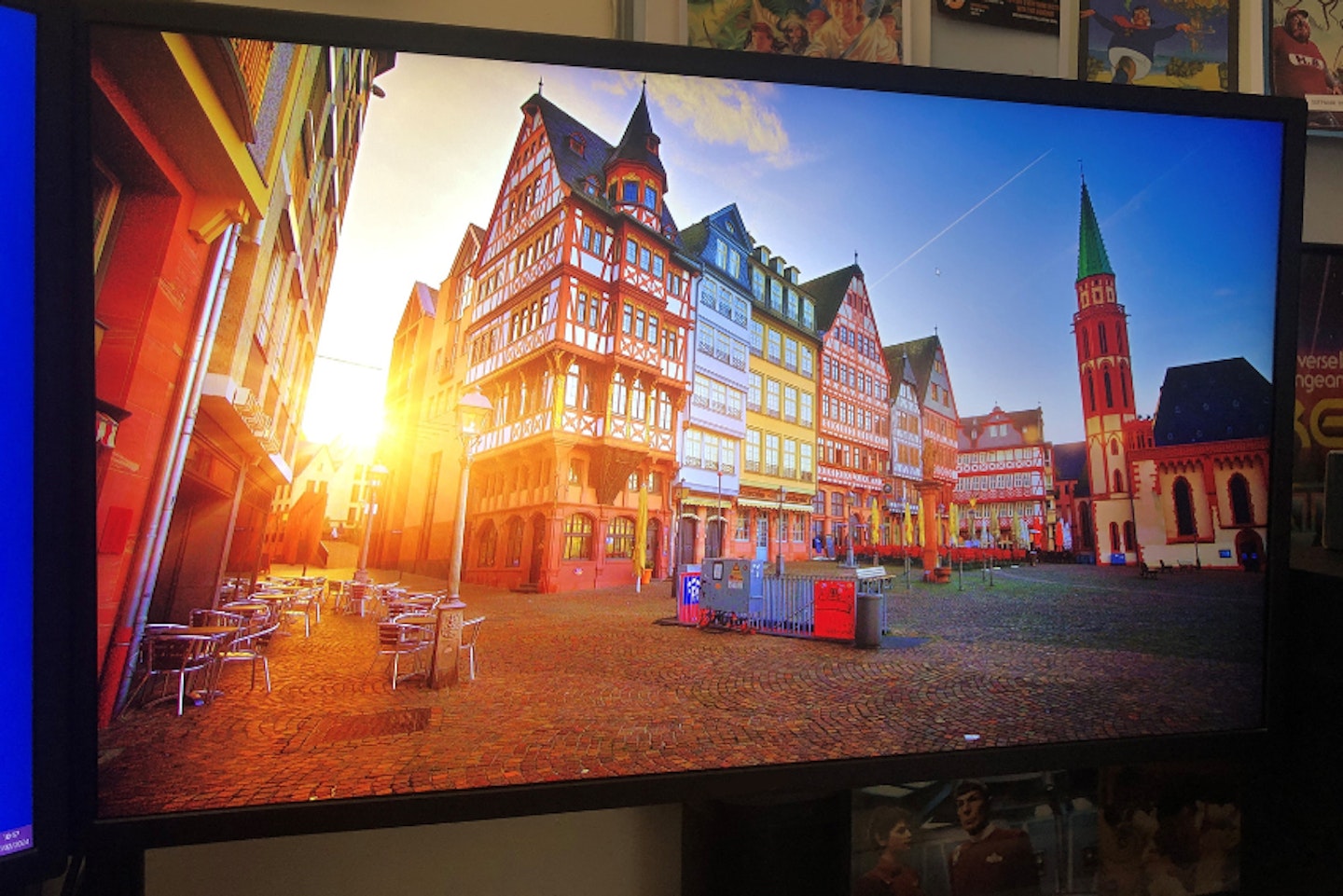
Best 4K monitors of 2024: Jargon buster
Refresh rate
The refresh rate is how often monitors update every second. So 60Hz means the monitor updates 60 times a second. In essence, this means the monitor's maximum frame rate is 60 frames per second. Higher refresh rates mean the monitor is more responsive and, if you are using it for games, the gameplay will look smoother. A high refresh rate running on something like a 4K curved monitor will really create a greater illusion of reality, thanks to the smooth motion and field of view.
Screen latency and response time
Latency, or input lag, is the time between when an event is triggered (such as moving, shooting etc.) and that event happening on-screen. Measured in milliseconds, a response time of anything below 70ms is acceptable, and under 40ms is excellent. The smaller the latency the better - it means you can react faster and with more accuracy in games. If this is too high, that means motion on the screen may produce 'ghosting' - or appear smeared as the pixels struggle to update fast enough.
HDR and colour gamut
A screen that supports HDR - or High Dynamic Range, will benefit from higher contrast levels and a vastly wider colour palette than standard screens. With over one billion colours to display, HDR10 and its close cousins will take your monitor to the next level. Similarly, the colour gamut is the range of colours a monitor can produce. The higher the colour gamut the more accurate your colours - and that's why designers prefer monitors that are calibrated or certified to universal colour standards, like sRGB or Adobe RGB.
Resolution
Resolution is the number of pixels on a display, expressed as height x width. The greater the number of pixels, the sharper the detail of the image. Some of the more common ones are below, but for a more comprehensive view, read our guide to TV and monitor resolutions.
HD = 720p - 1280 x 720 pixels
Full HD = 1080p - 1920 x 1080 pixels
Quad HD (QHD) = 1440p - 2560 x 1440 pixels, often referred to as 2K
4K UHD = 2160p - 3840 x 2160 pixels, also referred to as ‘Ultra HD resolution’
IPS panel
IPS panels (In-Plane Switching) are used in TVs and smartphones. They're more costly but generally have great colour ranges than standard TN panels. They can be an excellent choice for designers and gamers; gamers should be happy to hunt down an IPS panel with a high enough refresh rate and low enough response time though.
VA panel
VA panels, or Vertical Alignment panels, are a hybrid of both IPS and TN panels. They offer great colour and high refresh rates but sometimes suffer from motion blur or smearing. They're best suited to static office-type applications.
QLED / OLED / Mini LED
These are the new kids on the block in terms of base panel technology. Unlike the three above, which are generally based on LED panels, these three are new. They still support identical resolutions, but each has a new LED-based approach.
OLED display tech means that each organic LED pixel provides its own illumination. Known for its high contrast ratio and lighting precision, QLED uses tiny quantum dots instead of organic LEDs. It offers enhanced brightness and colour. Mini LED displays combine the best of the two above but with more light bleed. What you prefer the look of is down to you.
Adaptive Sync
There are currently two main contenders when it comes to screen sync technology: Nvidia G-Sync, and AMD FreeSync. These features are often built into monitors for gamers or anyone dealing the fast-moving graphics. Sometimes you'll find both built into the same monitor. It prevents screen tearing or stuttering at the same time as minimising motion blur. It does this in various ways, but mainly by varying the refresh rate of the screen to match the output from your graphics card.
Why should you trust us?
At What’s The Best, our mission is to provide accurate and reliable reviews, ensuring our readers receive honest and transparent information about the best technology products available. Anything less would undermine our commitment to being a trusted source of unbiased product information.
Our dedicated in-house writing team comprises experts with extensive experience and a genuine passion for technology. Collectively, we have spent decades testing and writing about tech, leveraging our expertise in all our articles, advice pieces and reviews.
We maintain complete editorial independence and do not accept payment for product reviews. Our writers have full control over their content, ensuring that products are selected based solely on the needs of our readers. While we may earn commissions or other compensation from links on our website, this never affects our product choices. These links enable us to continue offering valuable consumer advice, without compromising the integrity of our reviews.
Chris Duffill is a Senior Tech Writer and Reviewer for What's The Best and Yours. His background includes writing, editorial, marketing, design, video production and photography.
He specialises in home entertainment and audiovisual tech, including speakers, amplifiers, turntables, streaming media players, and TVs. He is also one of our resident experts in computing (PCs, tablets, smartphones, smartwatches), DSLR photography and all kinds of digital cameras. He also writes about retro gaming, game consoles and various electronic gadgets. If it plugs in, lights up or makes a noise, he’ll write about it.
Subscribe to the What’s The Best Newsletter to keep up to date with more of the latest reviews and recommendations from the rest of the What’s The Best team.
